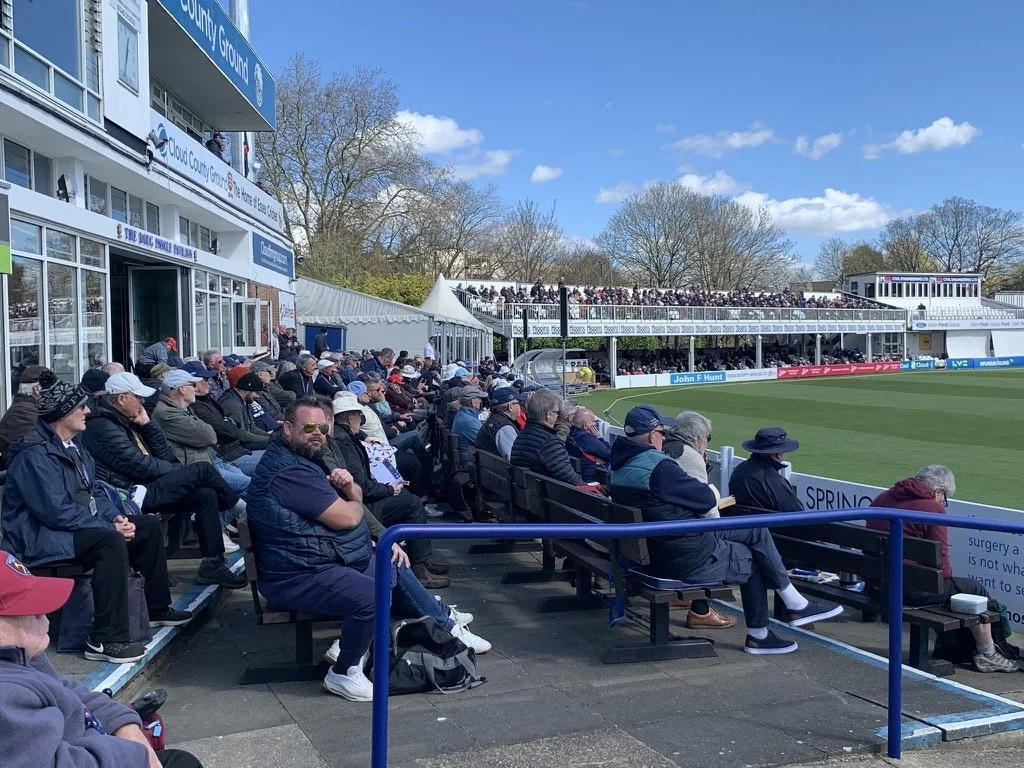The Grumbler's Team of the Bob Willis Trophy 2020
Somerest opener Tom Lammonby
September 27, The Cricket Paper
There was no chance to ease into the Bob Willis Trophy group stages this season. Players knew they would have five games, just ten innings, to make their mark. The two finalists, Essex and Somerset, had to register four wins and one draw in order to qualify. Yorkshire won three games, drew the others, topped their group but did not reach Lord’s. In compiling this team of the tournament, I have gone for consistency over a single stellar contribution. A number of centuries, fifties and five-fors outweigh a solitary double-ton. That is why neither Jordan Cox (238 not out) nor Jack Leaning (220 not out) make the squad despite setting a record all-wicket stand of 423 for Kent against Sussex and securing the top two scores of the season. Their feats only won one match. In contrast, Darren Stevens not only took 5-50 in the second innings of that game but secured his side a couple more crucial wins in another formidable season. Spoiler alert - the old warhorse makes the side but he will be surrounded by youngsters in the dressing room. Over 30 players have made their debuts in the Bob Willis Trophy this year, it was one of many positives produced by this innovative competition.
Tom Lammonby (Somerset)
Somerset relied on the youngster throughout the tournament. Even before his third ton of the event in the final, the 20-year-old was Somerset’s second-highest runs-scorer with 343 and hit two centuries. The 107 from 220 balls in the last-innings chase at Worcestershire sent the Westcountrymen to Lord’s. With wickets falling around him, the left-hander shepherded the tail and, in the process, scored over 50 per cent of Somerset’s runs. It was only the fifth first-class game of his career. “That innings was mature beyond his years, showing tremendous temperament and skill,” said skipper Tom Abell. “He has quickly evolved into a very important batsman for us in all formats.”
Sir Alastair Cook (Essex)
Class is permanent. The knight of the realm lived up to his billing with a masterful, under-pressure 172 in the final as Essex successfully chased down Somerset’s first-innings score. Cook finished the highest scorer in the competition with 563 runs, albeit from two innings more than Libby. He ended the tournament with an average of 56.3 having also hit a century against Hampshire in the group games. The left-hander stroked 77 fours, 18 more than anyone else, but did not hit a six. This is indicative of the calculated, unfussy method which was the backbone of the Essex success.
No player scored more runs in the group stages than Libby. He was two short of 500 runs in just nine innings, this included three 50s and 184 in 319 balls on his home debut against Glamorgan in the first week of August, part of a triple century partnership with Brett D’Oliveira. He also added 44 in the second innings and took a couple of wickets too. It was a fine way for the 27-year-old to establish himself after a move from Nottinghamshire last winter.
Charlie Thurston (Northamptonshire)
The 24-year-old finished the group stage with 357 runs in eight innings, just three less than another former-Bedford School pupil, Sir Alastair Cook. He hit a spritely 96 against Warwickshire in the opening round of fixtures then grabbed his first red-ball ton, plus a second-innings 64, in the victory over Glamorgan. In Thurston and left-handed batsman Emilio Gay, Northamptonshire have hope for the future.
Jordan Thompson (Yorkshire)
Although team-mate Ben Coad shone with 12 wickets in the final two fixtures, Jordan Thompson offered consistency throughout Yorkshire’s dominance of the North Group. In only his fourth first-class game, he hit 98 to dig his side out of a hole against Nottinghamshire in round two. The 23-year-old bats left-handed but his right-arm medium pace accounted for 15 wickets at 16.4 apiece. His maiden five-wicket haul against Leicestershire in the final round helped Yorkshire finish on a creditable 87 points.
Luis Reece (Derbyshire)
Given how much they rattled the powerhouse counties and delighted the neutrals this season, Derbyshire need some representation in the line-up. With one century, two fifties and 13 wickets at 26.15 in only four games, Luis Reece is perfect for the all-rounder role. His 122 at Durham was the seventh ton of his first-class career.
Adam Wheater (Essex)
The Essex wicketkeeper has always been somewhat in the shadows given he took the gloves from the exquisite James Foster after Ben Foakes had got tired of waiting, went to Surrey and won international honours. This season, Wheater emerged with 52 against Surrey and a match-winning 83 in the final group game against Middlesex, his highest score in three years. He came in with Essex struggling at 87-5 and remained unbeaten as they amassed a match-winning 238. There was similar stoicism in the latter stages of the final. His glovework has improved as exemplified by a spectacular one-handed catch from Tom Abell’s high, hanging leg-side flick on the opening day at Lord’s.
Simon Harmer (Essex)
The South African spinner came into the Bob Willis Trophy group stages with an adductor strain, he went into the final as the leading wicket-taker in the competition. His 34 victims came at a rate of one every 6.1 overs and a cost of 14 runs apiece. He would add a further four at Lord’s. The highlight was 14-131 in the victory over Surrey at Chelmsford. Before the final, he had amassed 251 first-class wickets since joining Essex in 2017, with 20 five-wicket hauls and five 10-fors. His red-ball form this year was stellar but barely raised an eyebrow. Excellence is expected from Harmer these days.
Darren Stevens (Kent)
After the apocalypse that wipes out mankind, all that will be left are scorpions, cockroaches and Darren Stevens bowling nagging away swing. The 44-year-old collected 29 wickets at 15.58 as Kent made a concerted late bid to top the South Group and no-one collected more five-fors at the Garden of England county. He’ll be back next year and, in all probability, he’ll be better still.
Craig Overton (Somerset)
Undoubtedly the leading pace bowler of the Bob Willis Trophy and seemingly untroubled by the departure of his twin brother to Surrey. His 28 wickets in the group stage came at an average of 10.71 and an economy rate of less than two-an-over. “Craig Overton is mint.” tweeted veteran Durham bowler Chris Rushworth. “Outside the playing Test team, he's the best bowler in the country in my opinion. Leading an attack that has bowled teams out for fun this year.”
Dan Moriarty (Surrey)
The 21-year-old was thrown in to make his debut after Surrey’s wretched early form left them out of contention. He played the last two games, taking three five-fors in four innings. The slow left-arm ended the groups with 17 wickets, 11 of those came in the final fixture against Sussex, five of which came in the first innings. He is one to watch next season.
12th man
Ben Duckett (Nottinghamshire)
Given he last played red-ball cricket for England in 2016, the label ‘former Test international’ may have been appropriate for Duckett at the start of this season. Despite playing in a Nottinghamshire side without a win since the middle of 2018, he pushed his case this season in the Bob Willis Trophy with 150 against Durham and 116 against Lancashire.
Last-Wicket Stand
Buy my book, Last-Wicket Stand through Amazon or get a signed copy through me.















